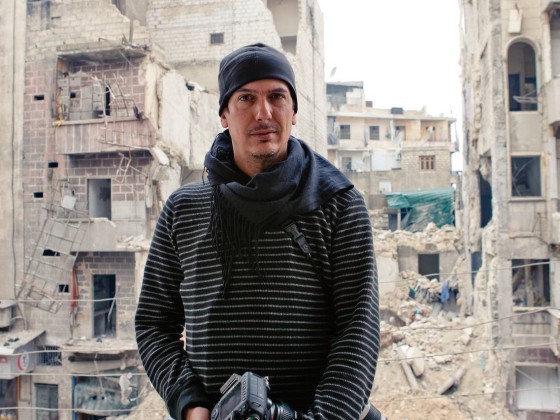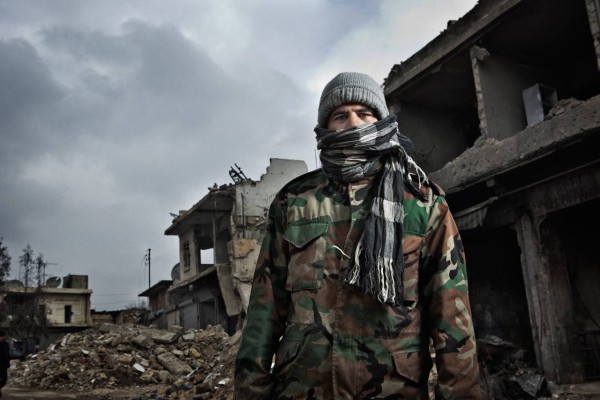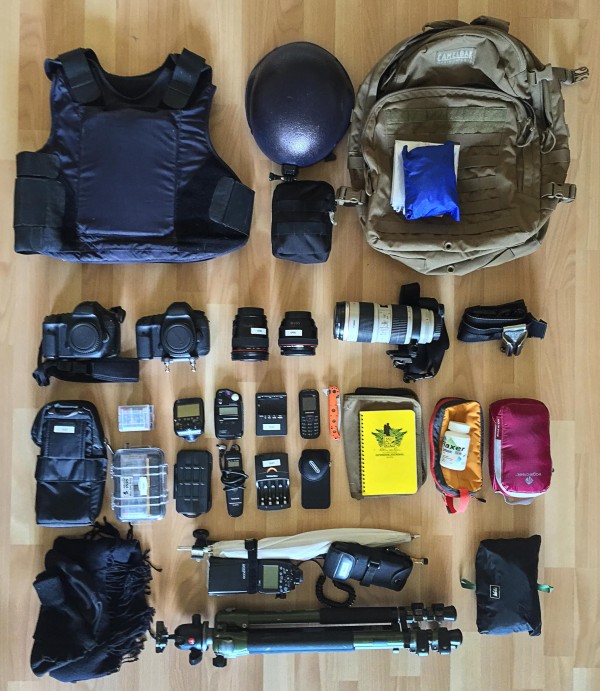Nish Nalbandian is a photojournalist, documentary photographer, and filmmaker who has worked in over 35 countries worldwide in a variety of environments and situations from wars to sporting events, back alleys to luxury resorts, from cities to remote deserts. He is most interested in making pictures and films that show the humanity of those he’s photographing and believes that curiosity, empathy, and compassion are what make for great photography.


What Journalists Carry on the Front Lines: Nish Nalbandian, Syria

Rukan, a female YPG fighter and unit leader aims her weapon from a fighting position in the Sheikh Maqsood districgt of Aleppo, Syria on April 19, 2013. The YPG (Popular Protection Units) of the Kurdish Democratic Union Party (PYD) considers itself a popular democratic militia with the mission of maintaining order and protecting the lives of those in the primarily kurdish districts of Syria. In March of 2013 the YPG and FSA began to cooperate in the conflict against the Syrian Regime.
Photo: Nish Nalbandian
Nish is a self-taught photographer who picked up his first DSLR in 2007, and has only been shooting professionally since 2011. He shot mostly travel and adventure when first starting, but in 2013 decided to focus on larger issues of the human condition, including conflict. While Nish does cover breaking news, he is more interested in following stories for a longer amount of time and creating stories that dig deeper. He is drawn by the desire to see and understand the lives of people living in their own communities far from his own.
View more of Nish’s work on his website and follow him online through Facebook, Twitter, and Instagram.
Here’s what he carries while covering conflicts all around the globe.
Row 1:
1. Second Chance Level III-A Vest with Ceramic Rifle Plates. The vest and plates work together to make a level IV system. I chose this system because it fits underneath a jacket or sweatshirt. While it does not provide as much coverage as the bigger vests, generally people cannot tell you are wearing it, making you less of a target.
2. Ballistic Helmet.
3. Med Kit with Celox Bandages and Tourniquet
4. Camelback Molle Backpack with rain cover and plastic bags to cover cameras.
Row 2:
1. 5DMk III body with strap
2. 5DMk III body with Spyder Plate
3. 24mm f1.4 for wide shots
4. 50mm f1.2 for low light (this is my favorite lens)
5. 70-200 f2.8 IS with strap Think Tank Thin Skin Belt with Spider Holster. (the Spyder holster is amazing. It allows you to carry a body with lens at your side hands-free and then access it quickly. )
Row 3:
1. Think Tank Flash Pouch for 2-6 below
2. Pelican case with 6 Mk III batteries and several sets of AA Batteries
3. Remote Flash Trigger
4. Waterproof case for extra cards (lots of them)
5. Light meter. I use this as much as I can when shooting portraits.
6. Intervalometer — I love timelapses
7. Chargers for AA and Mk III batteries
8. Burner phone (turned off, no iPhone for security reasons). I keep this and a burner wallet with a few bucks in it and an old driver’s licence in my front pocket.
9. iPod with headphones. To chill out at night.
10. Pocketknife. Absolutely necessary. Always in my pocket.
11. Case with documents, copies, press credentials, notebooks and pens. I always take laminated copies of my passport and hand those over when at all possible.
12. Toilet kit including wet naps, Gold Bond Powder, Big bottle of Ciproflaxin (diarrhea will keep you down. Take it when you first get loose and you’re fine.)
13. Bag with extra underwear and socks. I can last for weeks in the same clothes as long as I can change my underwear and socks.
Row 4:
1. Scarf, Hat, Gloves… I just bring a black scarf… I know it’s not as ‘cool’ as the checkered ones….
2. Light kit: Canon Speedlight 600, external battery pack, Manfrotto lightstand extender, and shoot-through umbrella with mount. I use this as my portrait kit. It doesn’t weight much, and I can use it to get great looking off camera lighting fast and easy.
3. Tripod and head. This is an old Manfrotto tripod that has literally been all over the world with me, used and abused. It straps onto the side of the pack.
4. Camp Towel. So if I do get a chance to wash up I can dry off. Also useable as a pillow. Dries quick because it’s microfiber.

A Syrian man poses for a portrait on February 8 in the rubble of buildings in Azaz, Syria which were destroyed by a government airstrike last year.
Photo: Nish Nalbandian
Not shown:
1. Irridium Satellite phone for daily checkins.
2. Macbook air (erased completely, nothing on it except for pictures)
3. Toughtek DUO mini RAID system (I keep my data on my cards, and backed up onto the RAID each night)
4. Pull-on boots. I hate taking time to have to unlace and re-lace my boots each time I go into someone’s house, so I buy nice pull on boots for quick exits.
5. Gaffer’s tape. This is one of the most necessary pieces of gear you can carry. It will fix almost anything, is reusable, and has replaced duct tape for me.
Packing:
All of it fits in the bag so I can leave the hotel and go for a week with everything I need. I transport it between hotels/countries with clothes and personal gear and tripods in a duffel and camera gear in a pelican case.
1The Frontline Freelance Register (FFR) is a representative body for freelancers, created and run by freelancers. It is an independent, ring-fenced entity which sits within the Frontline Club Charitable Trust with membership open to all freelance journalists working in conflict or foreign reporting. The FFR’s core objective is to support the physical and mental well-being of freelance journalists. In a world where staff jobs and fully paid foreign assignments are increasingly scarce, foreign and war reporting is dominated by freelancers, many of whom are deeply committed professionals doing outstanding work. At the same time, many of these freelancers lack the institutional support and the financial means to adequately manage the challenges of operating in dangerous environments in the long term. They also lack organised representation, often leaving them at the mercy of powerful media groups. FFR aims to help freelancers by providing them with a forum, a representative body, and a critical mass to face some of these challenges.

